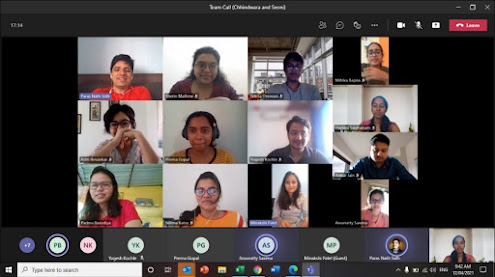


“Moooo,” I hear before I see ASHA Sahyogi* Shalini’s smiling face. A thick vermilion streak of sindoor* parts her hair. Shalini Verma. In Chhindwara, people always ask your last name. Squatting, she picks round, full bulbs, mostly white, a little lavender, from the ground. “Madam ji, pyaaz ka kaam chal raha hai, socha thoda ghar ka kaam kar loon.” (it’s time for the onion harvest, thought I’d do some housework). Her lanky son sits nearby, phone in hand, and follows my instructions on how to download the app we use to monitor AAA* meetings. She has a short window during which to use the phone, before the younger children come by to claim their source of entertainment; the same kids who some weeks ago, deleted the app while playing games. Her son is quick, he only needs to be told once. He’s wearing a red baseball cap. His mother is proud. We say bye. The cow demands our attention one last time before I hang up, “Moo…”.
And then silence. On my laptop, I’m faced with the team’s WhatsApp group chat. In green, I see a message I’d sent earlier that morning.
Today’s plan:
The sky had been overcast. Did the air smell like rain? On the chat, I see, “Team call at 5pm today”. I find myself eagerly awaiting these calls. Having been in Chhindwara, all away from our families, we had been in it together, until, a month ago, a few of us went back home to weather the lockdown. Now, each call begins with familial banter, before we share our approach to getting work done in our jurisdictions, remotely.

I don’t recall anyone asking us to say “Cheese” (Aditi – left-most, second from top)
Photo: Snapshot from a virtual team meeting
Home now, with great excitement concealed doubly now by masks, I step onto the patio to collect books home delivered by Amazon. Not long ago, I was on the field, witness to the near-home delivery that happened in rural India, of public health services. I’m home now, but the frontline workers carry on, delivering some services at the doorstep, literally, and others at the anganwadi centre in the village.
A part of every Tuesday and Friday, after the Village Health and Nutrition Day (VHND), is spent speaking with the ANM, ASHA, or AWW of the village where the VHND has taken place. If we’re lucky, we get past the can-you-hear-me’s and Zoom technical assistance and do a virtual AAA meeting. We discuss high-risk pregnant women and children, beneficiaries who missed a vaccine or check-up, the course of action being taken, and if things are happening on time, as per plan. During and after the VHND, the AAA update and match their registers.
It is easy to tell when their registers are matched incorrectly when you’re pouring over them, spread out in front of you. Now, I rely on government portals that reflect data entered by the frontline workers. Sometimes, when I call the supervisor, startled by data I see, she calls me back to say, “didi wahaan pe koi home delivery nahi hui hai, AWW se galti se ‘8’ dab gaya hoga, maine theek karva di.” (sister, no home delivery has happened, the AWW must have pressed ‘8’ by mistake, I’ve fixed it.) Maybe the error had only been in online data entry. Or, maybe the pages of the register had seen little ink. I can’t know.
If my phone is busy during the day, it is likely that on the other end is a frontline worker. When I call them, I’m met with the COVID announcement in Amitabh Bachchan’s baritone, or with music which could range from an Ed Sheeran song to a bhajan. From them, I hear that ANMs spend days other than VHNDs doing COVID vaccinations, that they worked even on Holi. From them I hear that the AAA are going door-to-door to test for COVID and survey eligible people. Stories of people getting aggressive with the AAA for trying to convince them to get the jab are, sadly, no rarity. It is hard to forget the photo of a note handwritten by an ANM. She did not feel safe administering COVID vaccines anymore. People in villages were correlating increase in vaccinations with increase in deaths, and they held the jab-ers responsible.
From them I hear about loss. “Yaar didi” (oh sister), some of them will say, before sharing with me their grief. Grief over having lost a family member. Grief over being unable to be physically present to comfort friends and family.
I was only too happy when I found out that Antara Foundation’s COVID response would be to provide essential supplies and protective equipment to frontline workers. Ensuring that supplies reached the frontline workers in Harrai – a brand new block for me – was to a large-extent, my responsibility. Back at it, more caller tunes kept me entertained, until I was graced by the voices of block officials, supervisors and ANMs. Route plans in place, cars stocked, nodal contact persons listed; we were set. Not bad for remote control.
Sometimes, in a day, I’ve worked in Kunda sector of Chourai block in Chhindwara, and in Ghansour block of Seoni, and in Harrai block in Chhindwara.
A month ago, I wondered, we go to the field, that is our work. How much can we get done from home?
Aditi Revankar is a fellow with The Antara Foundation.
Disclaimer: The article has been written in personal capacity, and the views and opinions expressed are those of the author
Notes
* ASHA Sahyogi: Government supervisor for ASHA workers, responsible for monitoring and handholding their activities
* Sindoor: A vermilion-coloured powder, a marker of marriage, used by women along the parting of their hair.
* AAA: Each A stands for one of the three frontline health workers – auxiliary nurse midwife (ANM), Accredited Social Health Activist (ASHA), and Anganwadi Worker (AWW).